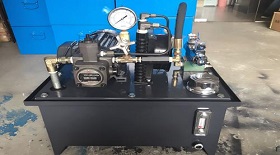Other control scheme for hydraulic system leakage control
Solution 1: reducing the wear of moving seal
Most of the movable sealing parts are precisely designed. If the movable sealing parts are qualified in processing, correctly installed and properly used, they can be guaranteed to work relatively without leakage for a long time. From a design perspective, the designer can use the following measures to extend the life of the movable seal.
1. Eliminating lateral loads on piston rod and driving shaft seals.
2. Protecting the piston rod with dust-proof ring, protective cover and rubber sleeve to prevent impurities such as abrasive and dust from entering.
3. Designing and selecting appropriate filter device and oil tank for cleaning to prevent dust from accumulating in oil.
4. Keeping the speed of piston rod and shaft as low as possible.
Scheme 2: requirements for static seals
Static seals fixed surfaces to prevent oil leakage. Properly designing the size and tolerance of sealing groove to make the sealing parts after installation deform to a certain compression so that the filling meets the micro depression of the surface, and increasing the internal stress of sealing parts to higher than the sealed pressure. When the part stiffness or bolt force is not enough, the mating surface will be separated under oil pressure, causing gaps or increasing gaps that may exist from the beginning due to the uneven sealing surface. As the surface moves, the static seal becomes the dynamic seal. Rough mating surfaces will wear out the seals and variable gaps will chip away at the edges of the seals.
Scheme 3: controlling the oil temperature to prevent the seal from deterioration
Premature deterioration of seals may be caused by a variety of factors. An important factor is high oil temperature. Temperature rise every 10 ℃ and seal longevity will be halved, so we should reasonably design efficient hydraulic system or set of forced cooling device to keep the best oil temperature under 65 ℃. Engineering machinery is not allowed to exceed 80 ℃. Another factor may be the compatibility problem between the used oil and sealing materials. The type and material of hydraulic oil and sealing parts should be selected according to the operation manual or related manual to solve the compatibility problem and extend the service life of sealing parts.



